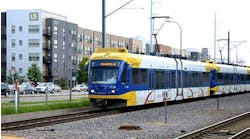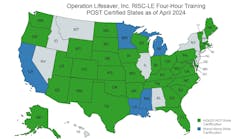Amtrak's vice president for high-speed rail is leaving, as the national rail company begins to integrate its high-speed rail and business development plans for the Northeast Corridor.
Al Engel, who took charge of high-speed development operations in September 2010, will leave Amtrak in December to pursue other opportunities, according to an Amtrak release issued last night. Engel, who previously had worked in the private sector, was responsible for Amtrak's increased investment in high-speed lines, including the development of an ambitious plan to bring 220-mph trains to the Northeast.
"I appreciate the opportunity I have had to work at Amtrak and guide the development of its high-speed rail program," Engel said in a statement. "Amtrak is vital to achieving true high-speed rail in the United States and it is my sincere hope that the initiatives we have launched will gather momentum and become reality."
The move came along with an announcement yesterday that Amtrak was restructuring its Northeast Corridor planning operations, integrating the existing high-speed rail development plans into a new Northeast Corridor Infrastructure and Investment Development business line. That, the company said, will bring the funding, policy and planning decisions for the agency's most profitable corridor under one roof.
Stephen Gardner, formerly the Amtrak vice president of policy and development, will lead the new department, the company said.
"The NEC is Amtrak's premier asset, and expanding high-speed rail service is essential to maximizing its success," said Amtrak President and CEO Joseph Boardman. "The NEC requires more capacity, greater connectivity and increased operating speeds for all corridor users. Improving and expanding our high-speed rail capabilities is central to achieving those goals."
As part of the new integration, Amtrak will release an updated vision plan for the Northeast Corridor by the end of the year, including new analysis of alignment, ridership, revenues and maintenance costs. A previous plan projected 220-mph trains in the corridor within 30 years at a cost of $117 billion, although no financial plan is in place. Amtrak has said it will incorporate private and public financing and has already secured $745 million in federal high-speed rail grants for the corridor.
The new business line will use infrastructure and land already owned by Amtrak to maximize financial performance and future operations for the Washington-New York City-Boston corridor, including passenger and freight railroad.
Amtrak's plans for the Northeast Corridor have come under fire from congressional Republicans, who say that Amtrak is ill-equipped to handle new high-speed rail service. Transportation and Infrastructure Chairman John Mica (R-Fla.) proposed a bill this summer that would wrest the NEC lines from Amtrak and open them up for private bids, which Mica said would get the line built faster and operating more reliably.
The restructuring signals a "step in the right direction," said Andy Kunz, president of the U.S. High-Speed Rail Association, who said Amtrak has not been "maximizing the value" of its Northeast holdings. The line regularly draws the most riders and profits for Amtrak, but critics say there is plenty of untapped potential in faster trains that could cut travel times in half.
Kunz said he will miss Engel, whom he praised for "setting Amtrak on a new course" and pushing high-speed rail to an agency usually concerned with just trying to break even.
"I think he helped ... show Amtrak that there's a new future and that they have to evolve into a leader in the rail industry by updating to true high-speed rail status," Kunz said. "I think Al's legacy will be getting them to think big and that they could be better. They have to innovate and think in terms of business development." Biodiesel trains hailed
Separately, Amtrak announced this week that a yearlong trial of a new biodiesel blend reported no mechanical or performance problems in locomotives. The B20 blend with 20 percent pure biofuel had been used on the daily Heartland Flyer train in Oklahoma and Texas.
The trial, which was funded in part by a $274,000 federal grant, found that locomotives displayed no additional wear than traditional diesel fuels and that there was no reduction in performance or reliability. Amtrak engineers also reported that air emissions were below EPA limits, although there was a 5 percent increase in smog-forming nitrogen oxides compared with traditional EPA-certified fuels.
Amtrak and the Federal Railroad Administration said they would explore further use of biodiesel based on the results.
Copyright 2008 LexisNexis, a division of Reed Elsevier Inc. All rights reserved.
Terms and Conditions |Privacy Policy


